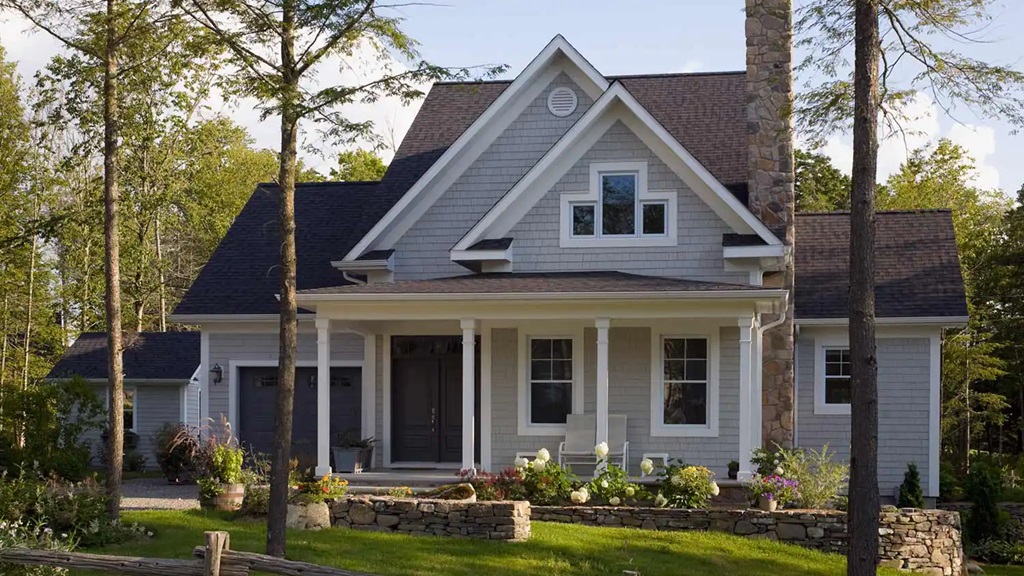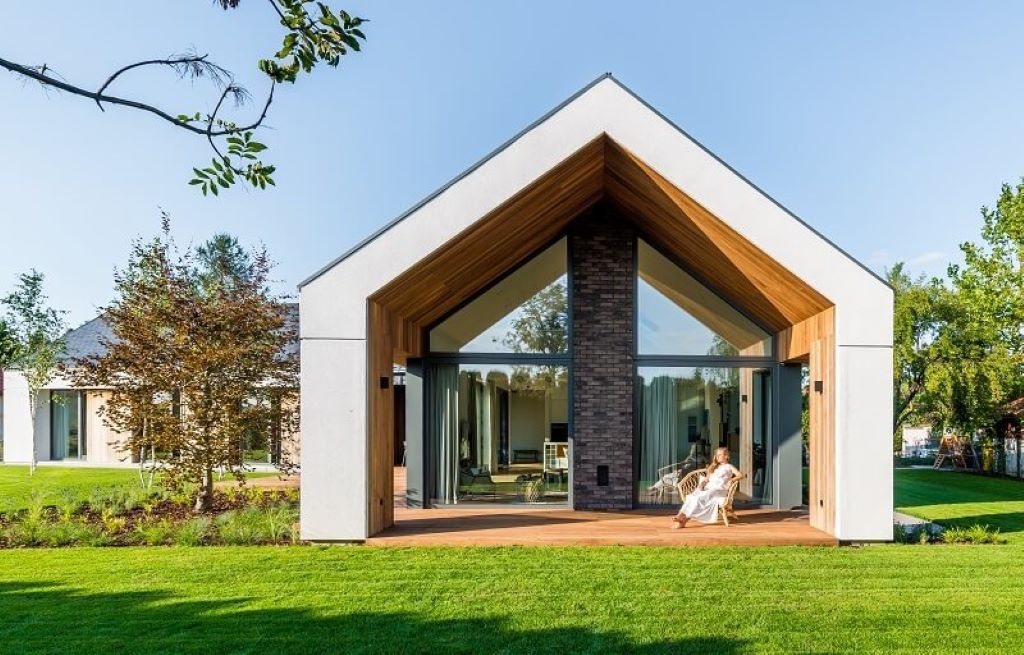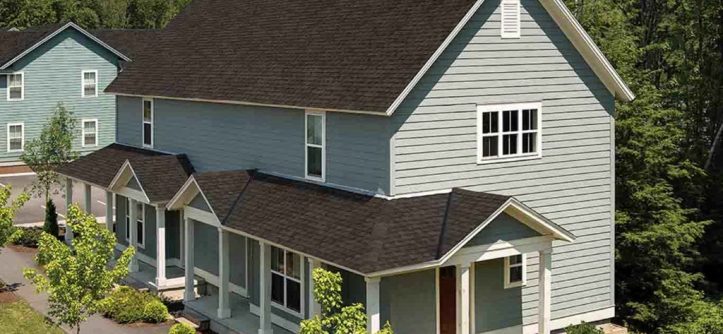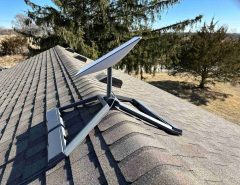A gable roof is a triangular roofing structure with two sloping sides that meet at the ridge. This design allows for rain and snow to easily slide off.
Gable roofs are among the most popular roof styles due to their simplicity and effectiveness. They offer excellent drainage and space for an attic or vaulted ceilings, which adds an airy feel to the interior space. This classic roof design also allows for more vertical wall space, which is ideal for additional windows or installing larger ones, enhancing both light and ventilation.
Contractors favor gable roofs because they are easier and more cost-effective to build compared to more complex designs. Their timeless appearance integrates well with a wide range of architectural styles, making them a versatile choice for many types of homes and buildings. With proper maintenance, a gable roof can provide reliable protection and aesthetic appeal for years to come.
Introduction To Gable Roofs

Defining The Gable Roof
A gable roof, commonly recognized by its inverted ‘V’ shape, is constructed with two roof panels pitched in opposite directions that come together at a ridge, forming a peak or gable at each end. This architectural staple is celebrated for its simplicity and effectiveness, qualities that contribute to its widespread use in residential housing across various geographies and climates.
Historical Significance Of Gable Roofs
The lineage of gable roofs extends back to ancient Greek and Roman architecture, where they were a feature of temples and public buildings, signifying grandeur and endurance. Over time, this roofing style disseminated across Europe and eventually to different parts of the world, evolving with cultural influences yet retaining its fundamental essence. Due to this progression, gable roofs have become a symbolic architectural element, often associated with the quintessential ‘home’ image.
Common Variations Of Gable Roofs
Despite its basic design, the gable roof comes in several adaptations, catering to various aesthetic preferences and functional requirements. Some of the most prevalent variations include:
- Cross Gable Roof: Features two or more gable roof lines that intersect at an angle, typically seen in homes with a complex layout.
- Front Gable Roof: Positioned at the entrance of a house, this design is often used in Colonial style homes, enhancing the entryway.
- Dutch Gable Roof: Combines the gable and hip roof styles to offer extra attic space or to add a distinctive aesthetic to the structure.
- Box Gable Roof: Contains a triangular extension at each end of the house, with the roof section boxed at the end.
Each variant provides a different set of advantages and can be tailored to suit the climate conditions, aesthetic desires, and practical necessities of a building.
Architectural Aesthetics And Design Features
Every element of a building’s design serves a purpose, most importantly the roof, which guards against the wrath of nature while adding to the visual story of the structure. Among the various roofing styles, the gable roof stands out for its simplicity and inherent beauty. In this section, we dive into the world of gable roofs—celebrating their aesthetic appeal, understanding the nuances of their design, exploring the materials that bring them to life, and comparing them to other popular roof types.
The Timeless Appeal Of Gable Roofs
Gable roofs have graced the silhouettes of buildings for centuries, synonymous with the classic depiction of ‘home’ in many children’s drawings. Their effortless charm isn’t just about nostalgia; it’s about versatility. The two pitched sides of a gable roof converge at a ridge, creating a triangular shape that is instantly recognizable. This iconic design not only blends well with a variety of architectural styles but also offers practical benefits, like easy snow and rainwater shedding.
Design Considerations For Building A Gable Roof
Before erecting a gable roof, several design factors need consideration to ensure both form and function harmonize:
- Pitch and slope must align with the local climate to handle weather conditions effectively.
- Understanding the building’s architecture to ensure a cohesive look.
- Assessing the internal space requirements, as gable roofs can provide additional attic or loft space.
- Considering local building codes and regulations, which may influence design constraints.
Gable Roof Materials And Textures
The selection of materials for gable roofs is not just about durability; it’s also about the textural aesthetic they bring to the building’s exterior. From traditional asphalt shingles and classic wood shakes to modern metal panels and sustainable clay tiles, each material offers a distinct look and feel:
- Asphalt Shingles: Affordable and widely available in various colors.
- Wood Shakes: Rustic charm with natural insulation properties.
- Metal Panels: Sleekness with longevity and resistance to extreme weather.
- Clay Tiles: Elegance with excellent durability and fire resistance.
Comparing Gable Roofs To Other Roof Types
While gable roofs remain popular, other roof styles offer alternative design and practical benefits. For instance, hip roofs have slopes on all four sides, offering enhanced stability and resistance to high winds. Flat roofs, prevalent in modern architecture, provide options for rooftop gardens or living spaces. Meanwhile, mansard roofs deliver additional living space under the roof, while gambrel roofs facilitate large attic spaces without the need for a traditional second floor. Comparatively, gable roofs are lauded for their simpler construction and timeless elegance.
Practical Aspects Of Gable Roofs
Advantages Of Gable Roof Construction
Gable roofs score high on the practicality scale for several compelling reasons. Their simplistic design not only enables quicker and often more cost-effective construction but also provides ample attic space and easy drainage systems. Here, we list some of the noteworthy benefits:
- Ease of design and construction: The straightforward structure of gable roofs makes them less complicated and less expensive to design and build.
- Cheaper materials: Due to their less complex architecture, gable roofs can be constructed with fewer materials, translating to savings on costs.
- Additional space: The space beneath the roof can be used for an attic or can be converted into extra living space, like a loft.
- Better water drainage: The sloped design ensures rain and snowmelt flow off easily, reducing the risk of water damage.
Weather Resistance And Durability
One of the defining features of gable roofs is their resilience against harsh weather. The steep pitch is not just visually appealing but also highly functional, serving as an effective shield against the elements. This design minimizes water pooling and snow buildup, thereby reducing the potential for leaks or structural strain. Furthermore, by opting for suitable materials and regular upkeep, a gable roof’s lifespan can be significantly extended, standing up to extreme conditions with ease.

Insulation And Ventilation Characteristics
When it comes to energy efficiency, gable roofs are a superior choice. Their design inherently offers excellent opportunities for insulation and ventilation, two critical factors in maintaining a comfortable indoor climate while reducing energy consumption.
| Insulation and Ventilation Benefit | Description |
|---|---|
| Optimal Insulation Space | The attic space provides ample room for insulation materials, contributing to better thermal performance. |
| Effective Ventilation | Well-designed gable roofs allow for a continuous airflow, which helps regulate temperature and prevents moisture accumulation. |
Both insulation and ventilation work in tandem to extend the roof’s life by preventing rot and mold, thus offering a perfect blend of comfort and durability.
Maintenance Tips For Gable Roofs
- Regular Inspections: Schedule professional inspections at least twice a year to identify and rectify potential issues early.
- Clean Gutters: Keep the gutters free of debris to ensure proper drainage and prevent water from backing up under the roof shingles.
- Trim Overhanging Branches: Cut back any branches that could damage the roof in a storm or drop leaves in the gutters.
- Spot Damage Early: Be vigilant about signs of wear such as cracked or missing shingles and get them replaced promptly.
Maintaining a gable roof ensures its structural integrity and aesthetic appeal over the years, allowing it to continue protecting your home as faithfully as it was designed to.
Incorporating Gable Roofs In Modern Architecture
Gable roofs have engraved their timeless essence in the pages of architectural history, standing as a testament to both durability and grace. This classic roof style, characterized by its triangular shape, has solidified its presence in the landscape of modern architecture. Designers and architects have embraced gable roofs for their versatility and inherent charm, seamlessly blending them with contemporary aesthetic sensibilities and innovations. This section explores how gable roofs continue to evolve and leave their mark in the world of modern design.
Innovations In Gable Roof Design
Today’s architects push the envelope, infusing gable roof designs with cutting-edge materials and technology. The innovations cater to eco-friendly practices, utilization of unconventional materials, and integration of smart home technology, all while maintaining the soul of the classic gable structure. Unique angles, mixed materials, and hybrid styles mark the evolution, making each gable roof both a statement and a solution.
- Eco-Friendly Materials: The use of sustainable materials in roofing systems is on the rise, reducing the environmental footprint.
- Smart Roofing: Integration of solar panels and energy-efficient systems makes gable roofs more than just a sheltering element.
- Hybrid Design: Blending gable roofs with other types, like flat or shed roofs, for a distinctive architectural aesthetic.
Case Studies: Notable Gable Roof Structures
Several impactful structures around the globe boast the use of gable roofs in a modern context. Here are some case studies:
| Project Name | Location | Architectural Highlights |
|---|---|---|
| The Triangle House | Japan | Minimalist design meeting maximalist functionality, this house makes the most of a gable roof in a compact urban space. |
| The Modern Barn | United States | A contemporary take on the farmhouse aesthetic, mixing rustic charm with sleek, modern lines. |
Future Trends In Gable Roof Construction
Advancement in technology alongside a growing emphasis on sustainability heralds a future where gable roofs are smarter and more adaptable. Expect to see:
- Innovative use of lightweight, yet strong, composite materials that enhance longevity and thermal performance.
- Increased integration of home automation systems controlling aspects like indoor climate, all through roofing configurations.
- Greater focus on architectural diversity, with gable roofs being tailored to a wide variety of building styles and personal tastes.
Choosing A Gable Roof For Your Home Or Project
When contemplating a gable roof for a new build or renovation, consider its curb appeal, functionality, and compatibility with modern trends. Factors to assess include:
- Climatic Suitability: Ideal for areas with heavy rain or snow, the sloping design allows for natural run-off.
- Aesthetic Value: A gable roof can lend a timeless appeal while offering scope for innovation in design.
- Energy Efficiency: Well-insulated gable roofs can contribute significantly to reducing energy costs.
Investing in a gable roof is a smart choice for those looking to blend tradition with modernity, creating spaces that are both functional and visually striking.
Conclusion: The Enduring Legacy Of Gable Roofs
Gable roofs have crafted a unique silhouette against skylines around the world, standing the test of time as a testament to their resilience, functionality, and simplicity. The archetypal design of a gable roof not only defines the essence of traditional architecture but also continues to influence contemporary building styles. Let’s explore the aspects of gable roofs that contribute to their lasting prominence in the realm of architecture.
Gable Roofs In The Context Of Global Architecture
Throughout history, gable roofs have been an architectural staple across numerous cultures. The adaptability of this design to various climates and materials has seen its implementation in European cottages, Asian temples, and American suburban homes. These roofs not only offer practical benefits such as shedding water and snow efficiently but also integrate seamlessly with diverse aesthetic and structural paradigms worldwide.
- Durability: Engineered to withstand heavy weather conditions.
- Versatility: Compatible with a range of materials from thatch to modern composites.
- Iconic Shape: Recognizable pitch characterizes traditional and modern skylines alike.
Why Gable Roofs Remain Popular Today
While architectural trends come and go, gable roofs maintain their relevance in contemporary building designs. Their simplicity offers a balance of cost-effectiveness and aesthetic appeal. Modern gable roofs can be found in urban developments and suburban settings, showcasing a blend of classic charm with innovative materials and energy-efficient insulating properties.
- Energy Efficiency: Attic space allows for effective insulation, reducing energy costs.
- Curb Appeal: Timeless design that is always in vogue.
- Practicality: Easy to construct and maintain.
Preservation Of Historical Gable Roof Structures
The valorization of historical gable roof structures underscores the value placed on our architectural heritage. Preservation efforts worldwide aim to maintain these cultural landmarks for future generations, recognizing their significance beyond mere functionality. These efforts often involve restoring materials and techniques true to the period, thereby safeguarding the integrity and beauty of these timeless structures.
| Preservation Steps | Benefits |
|---|---|
| Restoration of original materials | Upholds authenticity and value. |
| Application of protective treatments | Extends the lifespan of the roof. |
| Adherence to traditional methods | Ensures structural coherence and respect for heritage. |
In essence, the gable roof embodies a design principle that resonates across eras and borders. As new architectural trends emerge, the gable roof’s proven durability, adaptability, and timeless beauty ensure that it remains a cornerstone of both functional and aesthetic building standards. The enduring legacy of gable roofs is a blending of past and present—a tribute to architectural tradition that continues to shape our environments.
Frequently Asked Questions Of What Is A Gable Roof
What Is A Hip Roof Vs Gable Roof?
A hip roof has slopes on all sides, merging at the top, while a gable roof features two sloping sides that form a triangle at each end.
How Do I Know If I Have A Gable Roof?
To identify a gable roof, look for two sloping sides that come together at a ridge, forming a triangle on each end of the home. This design resembles an A-shape when viewed from the side.
What Are The Disadvantages Of A Gable Roof?
Gable roofs can struggle in high wind areas, as they are prone to damage. They also have potential for water leakage at the gable ends and require regular maintenance to prevent structural issues. Limited attic space is another disadvantage.
Why Is It Called A Gable?
The term “gable” originates from the Old French word “gable” or “gobel,” which refers to the triangular portion of a wall between the edges of a sloping roof.
Conclusion
Understanding the gable roof structure offers homeowners a traditional, durable choice for their abodes. It’s clear that its popularity stems from both aesthetic appeal and practical benefits. Hip Roof vs Gable Roof: Choosing the best design. Whether you’re building anew or renovating, the gable roof remains a reliable and stylish option. Prioritize your needs, consult with a professional, and your roof can combine form with function seamlessly, ensuring that your architectural choice not only meets your aesthetic preferences but also stands the test of practicality for years to come.”
Tags: architectural secrets, classic design, home improvement, residential architecture, roof construction, roof design ideas, roofing style, roofing trends, timeless charm




